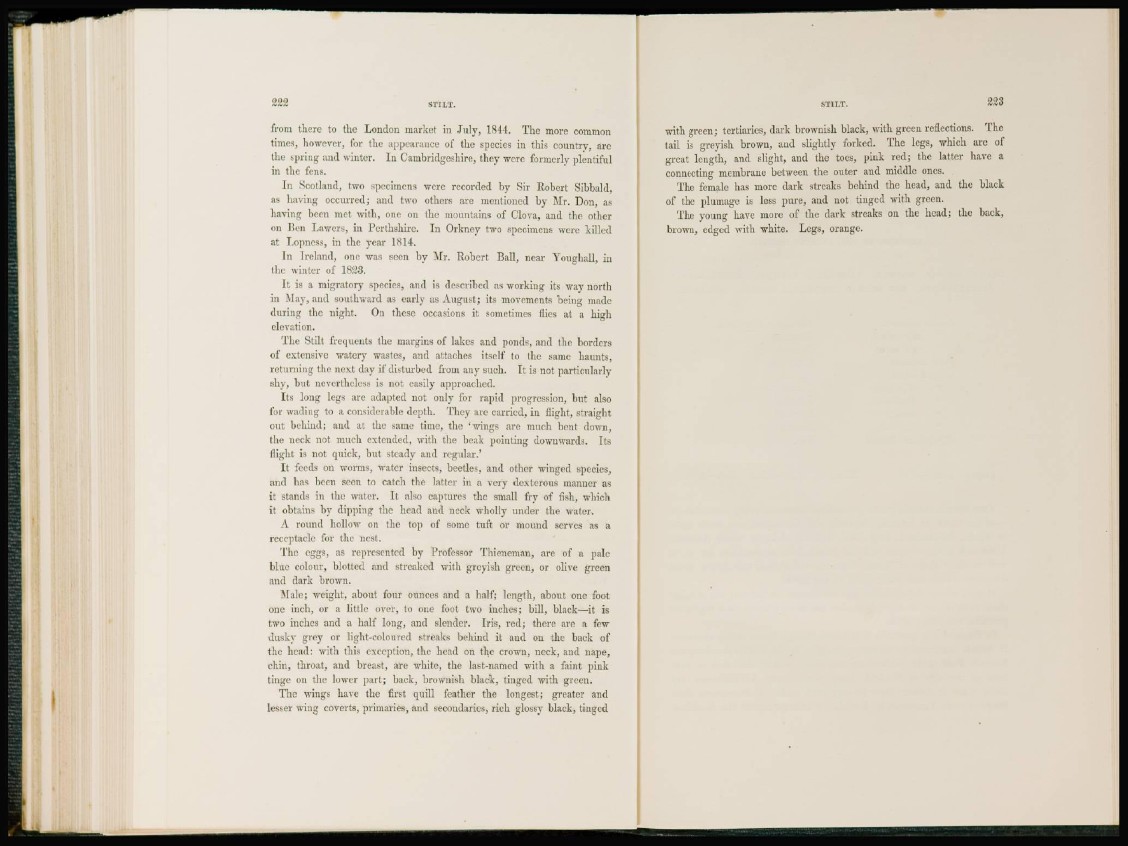
STILT.
from there to the London market in July, 1844. The more common
times, however, for the appearance of the species in this country, are
the spring and winter. In Cambridgeshire, they -were formerly plentiful
in the fens.
I n Scotland, two specimens were recorded by Sir Robert Sibbald,
as having occurred; and two others are mentioned by Mr. Don, as
having been met with, one on the mountains of Clova, and the other
on Ben Lawers, in Perthshire. In Orkney two specimens were killed
at Lopness, in the year 1814.
In Ireland, one was seen by Mr. Robert Ball, near Youghall, in
the winter of 1823.
I t is a migratory species, and is described as working its way north
in May, and southward as early as August; its movements being made
during the night. On these occasions it sometimes flics at a high
elevation.
The Stilt frequents the margins of lakes and ponds, and the borders
of extensive watery wastes, and attaches itself to the same haunts,
returning the next day if disturbed from any such. It is not particularly
shy, but nevertheless is not easily approached.
I t s long leg- are adapted not only for rapid progression, but also
for wading to a considerable depth. They arc carried, in flight, straight
out behind; and at the same time, the 'wings arc much bent down,
the neck not much extended, with the beak pointing downwards. Its
flight is not quick, but steady and regular.'
I t feeds on worms, water insects, beetles, and other winged species,
and has been seen to catch the latter in a very dexterous manner as
it stands in the water. It also captures the small fry of fish, which
it obtains by dipping the head and neck wholly under the water.
A round hollow on the top of some tuft or mound serves as a
receptacle for the nest.
The eggs, as represented by Professor Thieheman, are of a pale
blue colour, blotted and streaked with greyish green, or olive green
and dark brown.
Male; weight, about four ounces and a half; length, about one foot
one inch, or a little over, to one foot two inches; bill, black—it is
two inches and a half long, and slender. Iris, red; there are a few
dusky grey or light-coloured streaks behind it and on the back of
the head: with this exception, the head on the crown, neck, and nape,
chin, throat, and breast, are white, the last-named with a faint pink
tinge on the lower part; back, brownish black, tinged with green.
The wings have the first quill feather the longest; greater and
lesser wing coverts, primaries, and secondaries, rich glossy black, tinged
STILT. 223
with green; tertiarics, dark brownish black, with green reflections. The
tail is greyish brown, and slightly forked. The legs, which are of
great length, and slight, and the toes, pink red; the latter have a
connecting membrane between the outer and middle ones.
The female has more dark streaks behind the head, and the black
of the plumage is less pure, and not tinged -with green.
The young have more of the dark streaks on the head; the back,
brown, edged with white. Legs, orange.